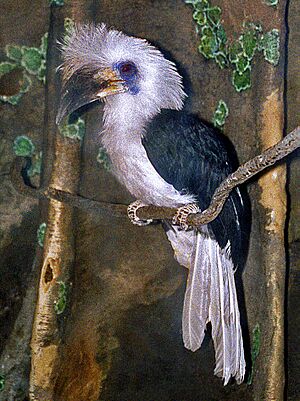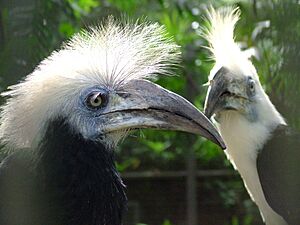White-crowned hornbill facts for kids
Quick facts for kids White-crowned hornbill |
|
|---|---|
 |
|
| Male | |
| Conservation status | |
| Scientific classification | |
| Synonyms | |
|
The white-crowned hornbill is a large and unique bird. It is also called the long-crested hornbill or white-crested hornbill. This bird is a type of hornbill, known for its special beak and crest. Its scientific name is Berenicornis comatus.
Contents
About the White-Crowned Hornbill
This hornbill is the only species in its group, called a genus, named Berenicornis. This means it is a "monotypic" species, being the only one of its kind in that specific group. Sometimes, people used to place it in a different genus called Aceros.
What Does the White-Crowned Hornbill Look Like?
The white-crowned hornbill is a very large bird. It can grow to be about 83 to 102 centimeters (33 to 40 inches) long. It weighs around 1.3 to 1.5 kilograms (2.9 to 3.3 pounds). Female hornbills are usually a bit smaller than the males.
These birds have striking black and white feathers. Their head, neck, chest, and tail are white. The rest of their body is black. They have a special crest of white feathers on their head, which is why they are called "white-crowned."
Around their eyes and on their throat, they have bare, dark blue skin. Their beak is mostly black with a yellowish part near the base. Like most hornbills, they have a blackish growth on top of their beak called a casque. Female hornbills have a black neck and black feathers on their underside.
What Do White-Crowned Hornbills Eat?
White-crowned hornbills are very protective of their home areas. They eat a variety of foods. Their diet includes different kinds of fruits, lizards, and small creatures like arthropods (insects and spiders). They also enjoy eating larvae, which are young insects.
Where Do White-Crowned Hornbills Live?
You can find this amazing bird in certain parts of Southeast Asia. It lives in the Malay Peninsula, which is a long strip of land. It also lives on the large islands of Sumatra and Borneo.
White-Crowned Hornbill Habitat
This hornbill prefers to live in tropical rainforests. They are usually found in areas that are not too high up, typically below 900 meters (about 3,000 feet) in elevation. Sometimes, they can also be seen in places where people grow fruit, oil palms, or rubber trees. Sadly, their homes are shrinking due to habitat destruction.
White-Crowned Hornbill Reproduction and Nesting
The way white-crowned hornbills raise their young is quite special. The female hornbill lays two white eggs inside a hole in a tree. After laying her eggs, she seals herself inside the nest. She uses her droppings, bits of plants, and mud to block the entrance. This keeps her and her eggs safe.
The male hornbill, along with other adult and young birds in their group, helps out. They form a cooperative group. They feed the mother and her chicks through a small, narrow hole in the sealed nest. When the young birds are old enough to fly, the female breaks open the "wall" and leaves the nest.
Threats to White-Crowned Hornbills
The biggest danger to the white-crowned hornbill is the loss of its forest home. The rainforests where these birds live have been disappearing very quickly in recent years. Because of this, the white-crowned hornbill is now considered an endangered species. It was moved from "near threatened" to "endangered" on the IUCN Red List in 2018. This means they are at a high risk of becoming extinct if we don't protect their habitat.



